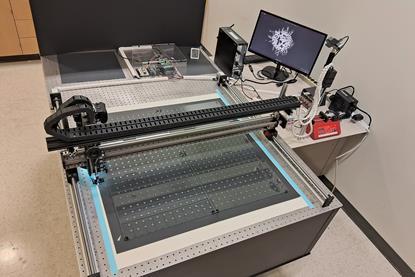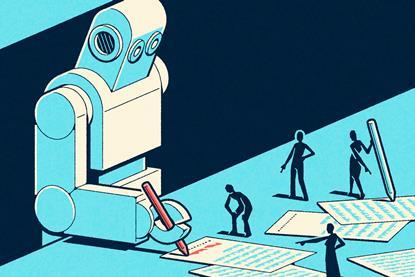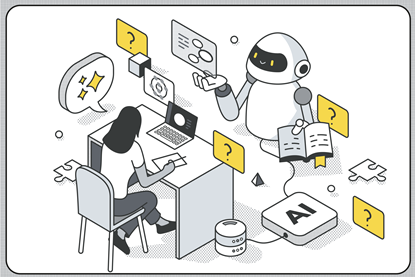AI and automation
In this collection, we explore the latest developments in artificial intelligence (AI) and automation, covering technologies and applications such as machine learning, robotics, laboratory automation and data analysis, and their impact on chemistry research, the profession, and chemistry-using industries.
The robots revolutionising chemistry
Researchers working with automated systems are pushing the boundaries of what chemists can achieve in the lab, reports James Mitchell Crow
What does AI mean for chemistry?
Phil Ball looks at whether letting machines do our thinking for us will change our understanding of chemistry itself
How to automate your lab
Whether it’s robots, automation or software hacks, Nessa Carson finds ways for everyone to improve how they work in the lab
The psychology of our future with AI
It’s time to accept that digitalisation is changing laboratory work, and embrace the opportunity
Encoding creativity in drug discovery
Machine learning can complement and reinforce human intuition and experience
How will AI and automation change chemistry?
It’s going to change our lives. But it’s not clear in what ways
You don’t need coding to be a chemist
Writing your own software can be useful, but what matters is knowing how to use it
Robots in the lab – learn how automation can streamline your workflow
The future of lab automation is promising. This webinar session reveals the answers to the most important questions in chemistry related automation today
SmartChemistry brings the power of AI and machine learning into your lab
Digital chemistry technologies provide the tools to accelerate your research
- Research
Robot ramps up accuracy of AI salt stain identifier
Database with three times as many images as before boosts accuracy of technique to almost 99%
- Research
AI inspired by AlphaFold can predict chromatin structures found in chromosomes
System could help unravel how genome folding influences genes
- News
Publishers need to provide guidelines on use of AI in research, says Wiley
Feedback from almost 5000 researchers helped inform publishing giant’s report
- Research
Generative AI pipeline creates promising antimicrobial peptides
AI model extrapolates beyond training data to predict diverse antimicrobial structures
- News
‘Chemistry will no longer be an exclusive club’: how AI is changing Omar Yaghi’s work
UC Berkeley’s reticular chemistry pioneer tells us about his new institute using AI to tackle climate change
- Research
How AI is transforming chemistry research
Artificial intelligence is revolutionising everything from workflows to networking - so how can you bring AI into your research practice?
- Opinion
Robots queuing up to fail
Claims of an AI revolution in drug discovery are missing the biggest problem
- Research
AI can tell Scottish and American whiskies apart
Machine-learning method identifies prominent aromas
- Research
Chemists use AI to uncover pigments used on Berlin Wall murals
Researchers hope work will help to preserve this art
- Research
GPT-based AI tool predicts inorganic crystal structures
CrystaLLM uses GPT to arrange atoms, turning text-based data into numerical tokens
- Opinion
There are no life lessons to be learned in AI’s Chinese Room
There’s a lot more lab work to do before we understand the ‘language of life’
- Whitepaper
Digital tools for deft materials development
Discover how Microsoft can help you turn years of lab work into days of computation
- Research
AI tool learns to build molecules fragment by fragment
Software tasked with designing a type-II kinase inhibitor suggests 97 candidates in 10 minutes, three of which were both synthesisable and effective at micromolar and nanomolar concentrations
- News
AlphaFold developer says AI is just getting started in science
Chemistry Nobel laureate John Jumper says latest version of AlphaFold is making good progress on interactions between molecules and protein
- Research
Large language models are better than humans at answering chemistry questions
AI models outperform human chemists in every topic area. But are they really better chemists?
- Research
AI robots work together to perform autonomous synthesis and analysis
System offers route for rapid testing, analysis and interpretation of a wide range of chemistries
- Opinion
Can the work of Professor R Obot be beautiful too?
The rise of AI raises questions about how we judge results
- Opinion
Did AI just win the Nobel prizes in physics and chemistry?
The importance of the expert eye in scientific progress
- Opinion
Large language models are great, but they don’t speak to me
AI has some made tremendous achievements, but some things mean more than words
- Opinion
This year’s chemistry Nobel proves it’s hard to make predictions
It’s been a long journey from the myoglobin model
- News
Twenty ways AI is advancing chemistry
List reveals how machine learning is already changing the central science
- Feature
How AI protein structure prediction and design won the Nobel prize
David Baker, Demis Hassabis and John Jumper won this year’s Nobel prize in chemistry. Jamie Durrani investigates the origins of a biochemistry revolution
- News
Explainer: Why have protein design and structure prediction won the 2024 Nobel prize in chemistry?
Research that has taken us from sequence to structure and back again
































